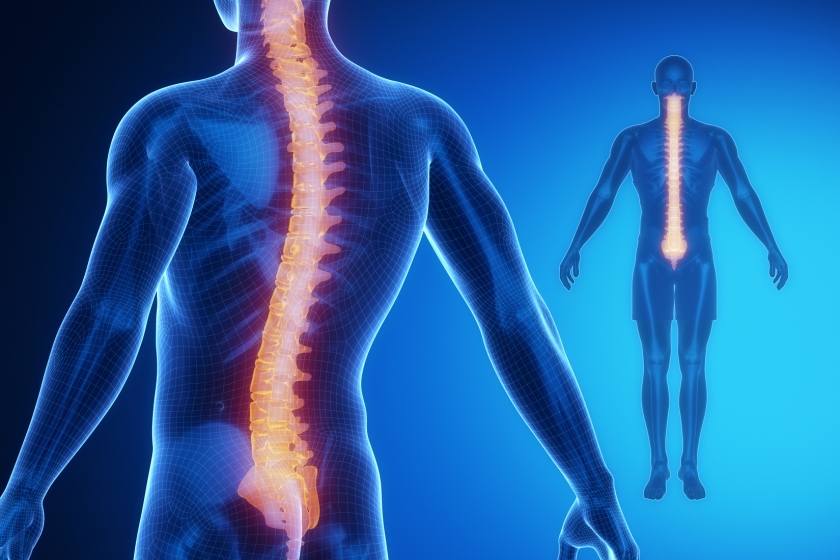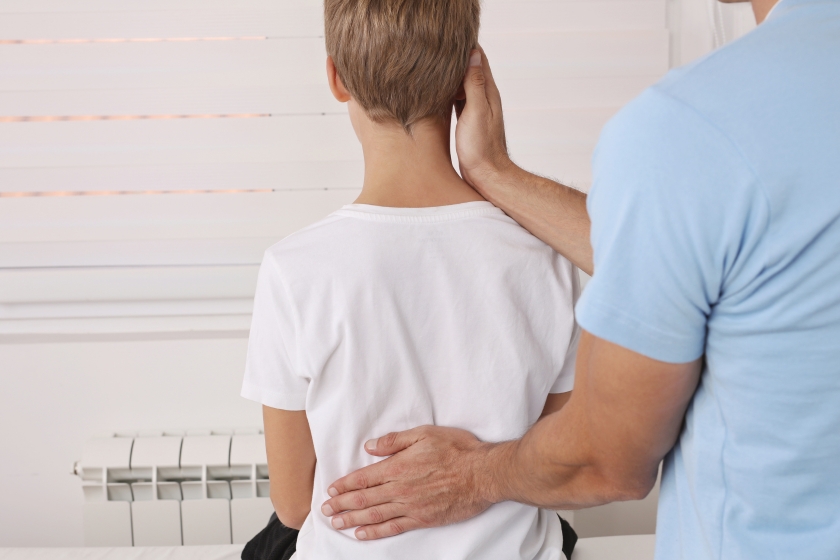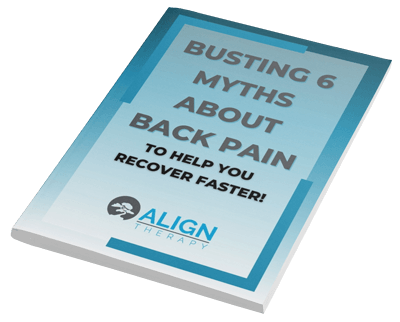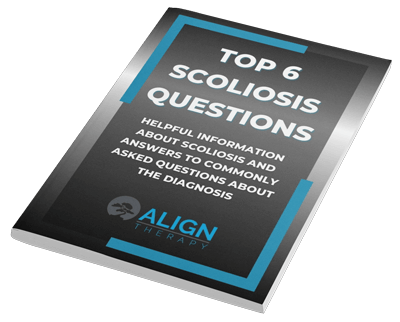At Align Therapy in Lehi, Utah, we see many different spine conditions including scoliosis, kyphosis, along with other deformities. One of the common questions we get from a parent when we see their child with scoliosis is, “Will it hurt?”.
For those who are adults with scoliosis, the question is somewhat different, but similar. “Will my back pain get worse because I have scoliosis?”, or something along those lines.
This is an interesting question considering scoliosis is a condition of the spine, and most people associate back problems with back pain. A quick overview of scoliosis and a review of current research can help answer this commonly asked question of whether or not scoliosis will cause back pain.

What is Scoliosis?
Scoliosis is a lateral curvature of the spine of 10 degrees or more. There is a lot of debate about what causes idiopathic scoliosis, but there seems to be a genetic cause most of the time. Other times there doesn’t seem to be a specific reason. Other known causes for scoliosis are from neurological origins, as well as after having surgery or radiation.
We see scoliosis curves usually increase during puberty, and the associated growth during that time, as well as in the later years of life during menopause and when degeneration of the spine occurs. With all that said, the origin of scoliosis can be complex and usually affects the actual structure of the spine.
In this blog post, I want to discuss some of the factors that may influence whether or not those with scoliosis will have back pain, along with my thoughts on what can be done to minimize this common complication of scoliosis!
Does Scoliosis Cause Back Pain?
What Other Providers Usually Say
Last week I had a teenage patient in my office that told an all too common story. They mentioned seeing a surgeon for their scoliosis and asked why they had back pain. To this question the surgeon said, “Oh, scoliosis doesn’t cause back pain”.
Now, this was confusing to the patient because they had been diagnosed recently with a fairly large scoliosis curve, and their back pain had increased more over the last year as their curve had gotten worse. To them, the scoliosis WAS causing their back pain. But, to the surgeon, the structural bony changes that cause scoliosis didn’t “cause” the back pain.
I share the frustration of the patient in this one. Does scoliosis “cause” back pain? Well, not necessarily, or all those with scoliosis would have back pain, which they don’t. But…could the scoliosis be a large contributing factor for why they have back pain? DEFINITELY!
When providers see someone who has scoliosis, they usually ask if they have back pain. I think we need to be careful of how this is phrased so as to not convince or influence the patient into thinking they should have back pain. Asking questions like “Do you have back pain?” is better than “How much back pain do you have?”. One is assuming they have back pain, and one is asking if they do.
The Scoliosis Research Society (SRS) states on their website “When scoliosis begins in adolescence, patients often report some back pain, typically in the low-er back. However, the general medical consensus is that spine curvature is probably not the cause of lower back pain in most adolescent scoliosis patients.” They explain this is most likely due to low back pain being common in general in the adolescent population.
I think the takeaway from this is that as providers, we need to make sure we address other causes for back pain if they are present, along with the scoliosis curve. Adults with scoliosis tend to have more back pain associated with their scoliosis curve because of some of these underlying issues combined with the scoliosis.
What the Research Says
Scholarly reviews and articles show mixed results on determining if scoliosis “causes” pain, but it is pretty clear that those with scoliosis tend to have more back pain than those without.
A study in 2024 in Spine Deformity examined the prevalence of back pain in adolescents with scoliosis. It found nearly half (48%) of those with scoliosis had back pain, where the general population of adolescents is at 33%. There were other factors that influenced who had back pain (e.g. insurance, age, location of the curve), but overall, there was more back pain in those with scoliosis.
In 2023, an article in the Journal of Clinical Medicine looked at 8 different studies to determine if adults with scoliosis have more back pain than their peers. The results showed more back pain in those with curves over 30 degrees and increased nerve issues with those who had curves over 40 degrees.
Another interesting statistic in that study is it reported a range of 38% to 60% rate of scoliosis in people over the age of 60. First of all, that is a HUGE range, but it also demonstrates that scoliosis in adults is a huge problem and needs to be addressed. An issue with research looking at adult scoliosis is that back pain is usually the reason they are coming in for treatment, and thus creates some bias in the studies.
From the other research studies I found, the takeaway was usually the same. The larger the curve, the more common the person has pain. Also, if we look at those with scoliosis as a whole, we see more back pain than the general population. Why that is the case is still debated in the literature and more studies need to be done.

Why Scoliosis Often Leads to Pain: The Role of Imbalances
Postural and Muscle Imbalances
As a physical therapist by trade, I look at the body as whether or not it is in balance and functions correctly. As a scoliosis specialist, this balance is even more important. With scoliosis being a 3 dimensional deformity, it naturally causes imbalance in all those with scoliosis.
Many times, when someone who has scoliosis goes in for a massage, the massage therapist will comment how much “bigger” or “tighter” the muscles on the convex side of their curve are, and they will proceed to “loosen them up”.
What they are actually feeling is the rotation of the spine, causing the ribs or the transverse processes of the spine to rotate backward on the convex side of the curve. It is not that those muscles are bigger or tighter, but that they are pushed more backward.
An interesting correlation, however, is that this area is the most common area for back pain in those with scoliosis. The rotation of the spine, along with the lateral curvature of the spine, causes significant stress to the convex muscles, resulting in muscle tightness, overuse, and spasm. The muscles on the convex side, however, can also be stressed due to being shortened and weak.
Add to that that most of those with scoliosis will have an imbalance of their pelvis, where the pelvis is not centered under their trunk. More muscle imbalance is present with this to hold that position against gravity.
All of these imbalances contribute to the muscles on one side of the spine working harder than those on the other. This in turn can cause pain.
Structural & Joint Stress
The lateral curve of the spine can also cause increased loading of the facet joints of the spine. As we age, these facet joints can develop arthritis anyway. Couple that with the uneven loading of the joint because of scoliosis and you have a recipe for more arthritis and degeneration on one side than the other.
Not only does this cause more pain on one side than the other, but it also can cause progression of the curve because one side is wearing out faster than the other.
There are other structures in the spine (e.g. spinal ligaments, discs, etc) which are loaded more on one side than the other and wear out faster or complain quicker because of the uneven load caused by scoliosis.
Bony structures like the ribs can also cause pain when they come in contact with the pelvic bone because of a large lumbar curve. This can cause significant pain in older people with scoliosis.
Nerve and Soft Tissue Irritation
Pain as a result of pinched nerves is much more common in adults with scoliosis, but can also happen at any age. The space where the nerves come out of the spine is less on the concave side of the curve, and can cause symptoms like sciatica.
Other soft tissue problems can result from the imbalance of scoliosis in other areas of the body as well. For example, shoulder impingement is common on the convex side of a thoracic curve because of the tipping of the shoulder blade. Hip bursitis is common on the side that the pelvis might be shifted toward because of increased load on the IT band.
What This Means for You (Or Your Child)
I think the big takeaway from this blog post is scoliosis doesn’t have to be painful…but it might be! If someone tells you your scoliosis shouldn’t be causing you pain, they are most likely wrong and you deserve a second opinion.
Those with scoliosis deserve to be treated by someone who understands the imbalances the spinal curve can create. There are many times I have seen a spinal curve brushed off as just an incidental finding, when it is a large player in the patient’s pain. Don’t discount it, especially if it is on one side of the body more than the other.
- Mild/Moderate adolescent curves typically aren’t painful, but imbalances can cause discomfort during activity. They still benefit from addressing.
- Degenerative adult curves are more likely to be painful owing to structural degeneration.
- Curve degree isn’t the sole pain predictor—factors like muscle imbalance, posture, activity level, and degeneration play key roles.

Comprehensive Approaches Backed by Research
Using scoliosis-specific exercises (e.g. Schroth Method) helps strengthen weak muscles and improve imbalances that can cause pain. Addressing the actual scoliosis curve is essential to getting to the root of the problem.
While core stabilization and stretching can be helpful for pain, it doesn’t address the underlying problem, which is the asymmetry. To do that, you need to work on the curve with a research backed approach.
The most evidence in the research has been focused on The Schroth Method, and this is our go to treatment at Align Therapy to help our patients address that underlying issue of scoliosis.
Other treatments (bracing, injections, medication, etc) can also be helpful and are best used in conjunction with scoliosis specific exercise.
Practical Tips for Parents & Adults
The following are my biggest suggestions for anyone who has been diagnosed with scoliosis, or who has a loved one with scoliosis, and is struggling with back pain.
- Early detection + treatment prevents progression and imbalances.
- Stay proactive: don’t wait for pain—address muscle imbalance, posture, and alignment early.
- Customized care is key: therapies like Schroth must be specific to the curve.
Monitor and maintain: even well-treated curves can shift over time, especially post-bracing, so follow up is key to prevent issues in the future.
Conclusion
Scoliosis may not directly cause pain, but the imbalances it creates absolutely can. The key to treatment is to address the underlying imbalance. Then, the actual problem becomes much easier to treat.
If you, or someone you care about, is struggling with back pain and scoliosis, check out our Free Discovery Visit where you can sit down with one of our specialist therapists and determine the best way to address your pain.
Make sure whatever you are doing is taking into account the scoliosis curve. It is an investment in the future as much as it is in your pain right now. Don’t wait! Click here or call (801) 980-0860 to book your free visit!
David Butler, Physical Therapist
More Free Resources:
Read our blog – Discover the Benefits of Physical Therapy for Managing Adult Scoliosis – Align Therapy Clinic, Utah
Check out what others are saying – Google Reviews
Learn more about us – Meet the Team



